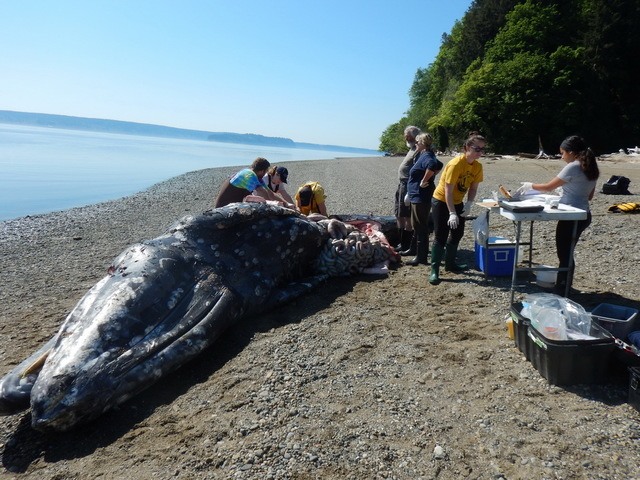A gray whale that was reported dead off of Vashon last week likely died of starvation, whale experts say, though it is not yet clear if there were additional causes that contributed to the animal’s condition.
Researchers retrieved the whale from the water between Vashon’s north end and Fauntleroy on April 19 and towed it to a remote location in the south sound, where they conducted the necropsy on the 29-foot long cetacean last Wednesday. The same whale, estimated to be a 15-month old male, was in the news earlier in the month, after it was spotted in the Ballard locks. While some who saw the whale there were excited, experts cautioned that that the animal was likely sick, given its atypical behavior.
“You just knew it was going to be an unfortunate outcome,” said Vashon’s Amy Carey of Sound Action.
A representative from the Orca Network called Carey on Monday, April 18, to investigate a report of a dead gray whale in Colvos Passage. Initially, she said, the whale was close to the upper beach at Lisabuela, but then the tide took it out, and the carcass eventually moved northward. The next morning, a state trooper onboard the ferry between Vashon and Fauntleroy reported the whale to the National Oceanic and Atmospheric Administration, which in turn contacted Vashon’s Ann Stateler, a stranding responder and part of the West Coast Marine Mammal Stranding Network. Aware of the report of a dead gray whale the day before, she said she was initially worried there were actually two dead gray whales near the island — which turned out not to be the case.
Later that day, representatives from Citizens for a Healthy Bay towed the whale away so that members of the umbrella group Northwest Marine Mammal Stranding Network could study it. Staff members of Olympia’s Cascadia Research Collective were involved in both efforts and shared the results of the necropsy online. According to the group’s website, the exam confirmed that the whale was emaciated, with little oil in the blubber layer. The stomach and intestines were mostly empty, but there were some indications it had tried to feed, as sand and a zip tie were included in the stomach contents. The animal’s tissues were in good condition, and from that evidence, researchers believe the whale died just a day or two before its body was first reported.
Jessie Huggins, the stranding research coordinator for Cascadia Research, said tissue samples will be tested and may yield additional information about the whale’s health in the coming weeks and months. She added that the whale had been starving for some time, and that its condition indicated it had not been getting enough to eat previously, likely in Alaska, and was not indicative of a food problem in Puget Sound.
Huggins also noted that another thin gray whale has been spotted recently in southern Puget Sound, and it is possible another gray whale death will be coming soon.
Huggins and her colleague marine biologist John Calambokidis say the whale’s death is part of a customary annual pattern. Typically, Calambokidis said, four to eight gray whales are reported dead each year in Washington, and this whale was the first reported this year.
Gray whale deaths in Washington occur most often in the spring, he said last week. Typically the deaths fall between April and June, as that time period coincides with the whales’ migration and the end of their seasonal fast, so they are often in the poorest condition during this time.
While seeing orcas near Vashon is common at certain times of the year, and the occasional humpback is typically of no concern, spotting gray whales near the island is often not a good sign, experts say.
Vashon is not on the animals’ migration pathway, Calambokidis said, and their presence here typically means one of two things.
“They could be in distress or exploring new places to feed,” he said. “Some might be in distress, and some might not be.”
Understanding gray whale behavior in Washington can be a challenging, Calambokidis added, as there are a few categories of gray whales found here.
About 20,000 gray whales are part of the Eastern North Pacific Gray whale population; those are the whales that migrate up and down the coast, he said. The stragglers seen in Puget Sound, including the whale found last week, are part of that group, which was migrating after leaving its winter breeding area in the far North and heading to Mexico.
A small number of whales — under a dozen — from that group stop and feed on ghost shrimp near Whidbey and Camano islands for a few months, typically from March until June.
“It is almost 150 miles off their migratory path,” Calambokidis added, noting that the whales learned about this productive feeding ground and keep coming back. “Part of what we have learned is that gray whales are pretty adaptive. They go and return. They are loyal to those areas.”
Finally, there is another group of gray whales frequently in Washington’s waters, the Pacific Coast Feeding Group. Its members number about 200, Calambokidis said, and they do not migrate, but rather, they live in the outer-coast waters between the northern coast of California up to British Columbia.
Gray whales are sometimes considered a success story of the ocean. After having had their numbers decimated by whaling, they began recovering steadily in the early 1900s, and in 1994, they were the first mammal to be removed from the endangered species list. Just a few years after that, Calambokidis said, thousands of the animals died along their Mexico-Alaska migration route, and in 1999-2000, 50 died in Washington State alone.
The news of last week’s whale death garnered considerable attention on Vashon and beyond and while it drew sad responses from many, Calambokidis stressed it was not unusual or alarming.
“This is a normal occurrence,” he said. “We are well below our annual average.”



